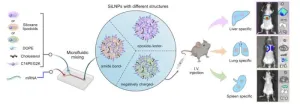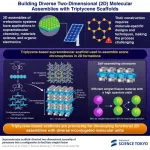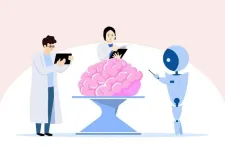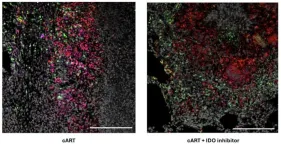(Press-News.org) UCLA researchers have developed a deep-learning framework that teaches itself quickly to automatically analyze and diagnose MRIs and other 3D medical images – with accuracy matching that of medical specialists in a fraction of the time. An article describing the work and the system’s capabilities is published in Nature Biomedical Engineering.
Unlike the few other models being developed to analyze 3D images, the new framework has wide adaptability across a variety of imaging modalities. The developers have studied it with 3D retinal scans (optical coherence tomography) for disease risk biomarkers, ultrasound videos for heart function, 3D MRI scans for liver disease severity assessment, and 3D CT for chest nodule malignancy screening. They say it provides a foundation that could prove valuable in numerous other clinical settings as well, and studies are planned.
Artificial neural networks train themselves by performing many repeated calculations and screening extremely large datasets examined and labeled by clinical experts. Unlike standard 2D images that show length and width, 3D imaging technologies add depth, and these “volumetric,” or 3D, images take more time, skill and attention for an expert’s interpretation. For example, a 3D retinal imaging scan may be composed of nearly 100 2D images, requiring a few-minute close inspection by a highly trained clinical specialist to detect delicate disease biomarkers, such as measuring the volume of an anatomical swelling.
“While there are many AI (artificial intelligence) methods for analyzing 2D biomedical imaging data, compiling and annotating large volumetric datasets that would be required for standard 3D models to exhaust AI’s full potential is infeasible with standard resources. Several models exist, but their training efforts typically focus on a single imaging modality and a specific organ or disease,” said Oren Avram, PhD, a postdoctoral researcher at UCLA Computational Medicine and a co-first author of the paper.
The UCLA computer model, called SLIViT, for SLice Integration by Vision Transformer, consists of a unique combination of two artificial intelligence components and a unique learning approach that researchers say allow it to accurately predict disease risk factors from medical scans across multiple volumetric modalities with moderately sized labeled datasets.
“SLIViT overcomes the training dataset size bottleneck by leveraging prior ‘medical knowledge’ from the more accessible 2D domain,” said Berkin Durmus, a UCLA PhD student and co-first author of the article. He and Avram are researchers affiliated with the UCLA Henry Samueli School of Engineering and other UCLA schools and departments.
“We show that SLIViT, despite being a generic model, consistently achieves significantly better performance compared to domain-specific state-of-the-art models. It has clinical applicability potential, matching the accuracy of manual expertise of clinical specialists while reducing time by a factor of 5,000. And unlike other methods, SLIViT is flexible and robust enough to work with clinical datasets that are not always in perfect order,” Durmus said.
Avram said SLIViT’s automated annotation may benefit patients and clinicians by improving diagnostic efficiency and timeliness, and it advances and expedites medical research by reducing data acquisition costs and duration. Additionally, it provides a foundation model to accelerate development of future predictive models.
“What thrilled me most was SLIViT’s remarkable performance under real-life conditions, particularly with low-number training datasets,” said SriniVas R. Sadda, MD, a professor of Ophthalmology at UCLA Health and the Artificial Intelligence & Imaging Research director at the Doheny Eye Institute. “SLIViT thrives with just hundreds – not thousands – of training samples for some tasks, giving it a substantial advantage over other standard 3D-based methods in almost every practical case related to 3D biomedical imaging annotation.”
Eran Halperin, PhD, a professor of Computer Science at the Henry Samueli School of Engineering and Computational Medicine at the UCLA David Geffen School of Medicine, said that even if financial resources were unlimited, ongoing research will always face challenges posed by limited training datasets – in clinical environments, for instance, or when considering emerging biomedical-imaging modalities.
“When a new disease-related risk factor is identified, it can take months to train specialists to accurately annotate the new factor at scale in biomedical images,” he said. “But with a relatively small dataset, which a single trained clinician can annotate in just a few days, SLIViT can dramatically expedite the annotation process for many other non-annotated volumes, achieving performance levels comparable to clinical specialists.”
Halperin and Sadda are co-senior authors of the paper.
In addition to expanding their studies to include additional treatment modalities, the researchers plan to investigate how SLIViT can be leveraged for predictive disease forecasting to enhance early diagnosis and treatment planning. To promote its clinical applicability, they also will explore ways to ensure that systematic biases in AI models do not contribute to health disparities.
# # #
Authors A full list of authors is provided with the article.
Funding This work was supported by National Institutes of Health/National Institute of General Medical Sciences grant 5R25GM135043, NIH/National Institute of Biomedical Imaging and Bioengineering grant R01EB035028, NIH/National Eye Institute grants R01EY023164 and 1R01EY030614, and an Unrestricted Grant from Research to Prevent Blindness Inc. This research was conducted using the UK Biobank Resource under application #33127.
Article Accurate prediction of disease-risk factors from volumetric medical scans by a deep vision model pre-trained with 2D scans. Nature Biomedical Engineering DOI: 10.1038/s41551-024-01257-9.
END
New AI model efficiently reaches clinical-expert-level accuracy in complex medical scans
Framework has wide adaptability across a variety of imaging modalities
2024-10-01
ELSE PRESS RELEASES FROM THIS DATE:
Cool roofs could have saved lives during London’s hottest summer
2024-10-01
As many as 249 lives could have been saved in London during the 2018 record-setting hot summer had the city widely adopted cool roofs, estimates a new study by researchers at UCL and the University of Exeter.
The paper, published in Nature Cities, analysed the cooling effect that roofs painted white or other reflective colours would have on London’s ambient temperature between June and August 2018, the city’s hottest summer. From June through August, the average temperature around London was 19.2 degrees C, about ...
Solidarity drives online virality in a nation under attack, study of Ukrainian social media reveals
2024-10-01
While divisive social media posts get more traction in countries such as the US, a new study shows that celebrating national unity is the way to go viral in Ukraine.
“Ingroup solidarity” statements got far more likes and shares than hostile posts about Russians – a trend that only grew stronger in the wake of the invasion.
The first major study of social media behaviour during wartime has found that posts celebrating national and cultural unity in a country under attack receive significantly more online engagement than derogatory posts about the aggressors.
University of Cambridge psychologists analysed a total of 1.6 million ...
Research heralds new era for genetics
2024-10-01
UNDER STRICT EMBARGO UNTIL 10AM (UK TIME) ON TUESDAY 1 OCTOBER 2024.
Peer reviewed | Observational study | People
Research led by scientists at Queen Mary University of London is heralding in a new era for genetic sequencing and testing.
In the largest study of its kind to date, published today in Nature Medicine, an international group of researchers led by Queen Mary used new bioinformatics techniques to scan the genetic profiles of 80,000 people to understand the frequency of specific expansions of short repetitive DNA sequences in the general population.
These expansions are the most common cause of inherited neurological ...
Deep brain stimulation instantly improves arm and hand function post-brain injury
2024-10-01
Deep brain stimulation may provide immediate improvement in arm and hand strength and function weakened by traumatic brain injury or stroke, University of Pittsburgh School of Medicine researchers report today in Nature Communications.
Encouraging results from extensive tests in monkeys and humans open a path for a new clinical application of an already widely used brain stimulation technology and offer insights into neural mechanisms underlying movement deficits caused by brain injury.
“Arm and hand paralysis significantly impacts the quality ...
Siloxane nanoparticles unlock precise organ targeting for mRNA therapy
2024-10-01
Penn Engineers have discovered a novel means of directing lipid nanoparticles (LNPs), the revolutionary molecules that delivered the COVID-19 vaccines, to target specific tissues, presaging a new era in personalized medicine and gene therapy.
While past research — including at Penn Engineering — has screened “libraries” of LNPs to find specific variants that target organs like the lungs, this approach is akin to trial and error. “We’ve never understood how the structure of one key component of the LNP, ...
Building better solar cells: assembly of 2D molecular structures with triptycene scaffold
2024-10-01
Research in the field of material science and electronics relies on the innovative arrangement of molecules or atoms to develop materials with unique properties not found in conventional materials. Two-dimensional (2D) assemblies of π-electronic systems, arranged in thin layers, are becoming increasingly important in the fields of materials science and organic electronics. Their unique arrangement allows for specific electronic and physical properties, making them ideal for applications like solar cells, and flexible displays. However, creating such assemblies is challenging because it often requires special designs and techniques for each ...
Maybe we shouldn’t even call low-grade prostate cancer “cancer”
2024-10-01
A new paper in the Journal of the National Cancer Institute, published by Oxford University Press, indicates that patients may benefit if doctors stop calling certain early-stage changes to the prostate “cancer” at all.
Prostate cancer is the second leading cause of cancer death worldwide in men, but far more patients are diagnosed than die of the disease. In 2022, there were nearly 1.5 million cases of prostate cancer, but only 400,000 deaths. Low-grade prostate cancer, commonly known as GG1 among physicians, virtually never metastasizes or causes symptoms. Some medical researchers have wondered recently if it would be a benefit ...
‘Cheeky’ discovery allows scientists to estimate your risk of dying using cells found in the mouth
2024-10-01
We don’t all age at the same rate. But while some supercentenarians may age exceptionally slowly due to winning the genetics jackpot, a plethora of behavioral and lifestyle factors are known to speed up aging, including stress, poor sleep, poor nutrition, smoking, and alcohol. Since such environmental effects get imprinted on our genome in the form of epigenetic marks, it is possible to quantify molecular aging by characterizing the epigenome at prognostic genomic sites.
Over the past decade, scientists have developed several such ‘epigenetic clocks’, calibrated against chronological age and various lifestyle factors across large ...
ChatGPT shows human-level assessment of brain tumor MRI reports
2024-10-01
As artificial intelligence advances, its uses and capabilities in real-world applications continue to reach new heights that may even surpass human expertise. In the field of radiology, where a correct diagnosis is crucial to ensure proper patient care, large language models, such as ChatGPT, could improve accuracy or at least offer a good second opinion.
To test its potential, graduate student Yasuhito Mitsuyama and Associate Professor Daiju Ueda’s team at Osaka Metropolitan University’s Graduate ...
Promising TB therapy safe for patients with HIV
2024-10-01
SAN ANTONIO (October 1, 2024) – A therapy showing promise to help control tuberculosis (TB) does not interfere with combined antiretroviral therapy (cART), according to research by Texas Biomedical Research Institute (Texas Biomed).
“This is an important hurdle that this host-directed therapy had to clear in order to help patients battling both HIV and TB,” said Texas Biomed Professor Smriti Mehra, Ph.D., who led the study recently published in the peer-reviewed journal JCI Insight.
TB is responsible for more than 1.3 million deaths worldwide every year. Dr. Mehra ...
LAST 30 PRESS RELEASES:
Scientists trace microplastics in fertilizer from fields to the beach
The Lancet Obstetrics, Gynecology, & Women’s Health: Taking paracetamol during pregnancy does not increase risk of autism, ADHD or intellectual disabilities, confirms new gold-standard evidence review
Taking paracetamol during pregnancy does not increase risk of autism, ADHD or intellectual disabilities
Harm reduction vending machines in New York State expand access to overdose treatment and drug test strips, UB studies confirm
University of Phoenix releases white paper on Credit for Prior Learning as a catalyst for internal mobility and retention
Canada losing track of salmon health as climate and industrial threats mount
Molecular sieve-confined Pt-FeOx catalysts achieve highly efficient reversible hydrogen cycle of methylcyclohexane-toluene
Investment in farm productivity tools key to reducing greenhouse gas
New review highlights electrochemical pathways to recover uranium from wastewater and seawater
Hidden pollutants in shale gas development raise environmental concerns, new review finds
Discarded cigarette butts transformed into high performance energy storage materials
Researchers highlight role of alternative RNA splicing in schizophrenia
NTU Singapore scientists find new way to disarm antibiotic-resistant bacteria and restore healing in chronic wounds
Research suggests nationwide racial bias in media reporting on gun violence
Revealing the cell’s nanocourier at work
Health impacts of nursing home staffing
Public views about opioid overdose and people with opioid use disorder
Age-related changes in sperm DNA may play a role in autism risk
Ambitious model fails to explain near-death experiences, experts say
Multifaceted effects of inward foreign direct investment on new venture creation
Exploring mutations that spontaneously switch on a key brain cell receptor
Two-step genome editing enables the creation of full-length humanized mouse models
Pusan National University researchers develop light-activated tissue adhesive patch for rapid, watertight neurosurgical sealing
Study finds so-called super agers tend to have at least two key genetic advantages
Brain stimulation device cleared for ADHD in the US is overall safe but ineffective
Scientists discover natural ‘brake’ that could stop harmful inflammation
Tougher solid electrolyte advances long-sought lithium metal batteries
Experts provide policy roadmap to reduce dementia risk
New 3D imaging system could address limitations of MRI, CT and ultrasound
First-in-human drug trial lowers high blood fats
[Press-News.org] New AI model efficiently reaches clinical-expert-level accuracy in complex medical scansFramework has wide adaptability across a variety of imaging modalities




